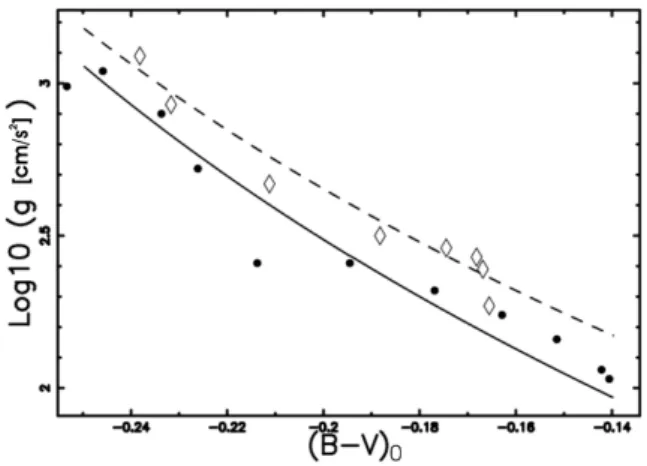Original scientific paper
SEMI-ANALYTICAL FORMULAS FOR THE FUNDAMENTAL
PARAMETERS OF GALACTIC EARLY B SUPERGIANTS
L. Zaninetti
Dipartimento di Fisica Generale, Via Pietro Giuria 1 10125 Torino, Italy
E–mail: zaninett@ph.unito.it
(Received: May 21, 2009; Accepted: August 7, 2009)
SUMMARY: The publication of new tables of calibration of some fundamental parameters of Galactic B0-B5 supergiants in the two classes Ia and Ib allows to
particularize the eight parameters conjecture that model five fundamental parame-ters. The numerical expressions for visual magnitude, radius, mass, luminosity and surface gravity are derived for supergiants in the range of temperature between 29700 K and 15200 K. The availability of accurate tables of calibration allows us to estimate the efficiency of the derived formulas in reproducing the observed values. The average efficiency of the new formulas, expressed in percent, is 94 for the visual magnitude, 81 for the mass, 96 for the radius, 99 for the logarithm of the luminosity and 97 for the logarithm of the surface gravity.
Key words. Stars: fundamental parameters – Hertzsprung-Russell (HR) and C-M – Stars: general
1. INTRODUCTION
A recent study on the supergiants of spectral type B0-B5, see Searle et al. (2008), provided a fine grid of the fundamental parameters such as the temperature, luminosity, radius, surface gravity and mass. In this paper we first review the four funda-mental parameters as modeled by the eight param-eters conjecture and we add to the list the surface gravity, see Section 2. Section 3 contains the numer-ical expressions for five fundamental parameters as well as the efficiency of such an evaluation.
2. THE FUNDAMENTAL FORMULAS We briefly review the formulas that charac-terize the visual magnitude,MV, the mass, M, the
radius, R, and the luminosity, L, of the stars for
each MK class as function of the intrinsic, unred-dened color index (B−V)0, see Zaninetti (2008) for details. The first equation models the visual magni-tude, MV
MV =−2.5aLM−2.5bLMaMT−
2.5bLMbMTlog10(
TBV (B−V)0−KBV
)
−KBC+ 10 log10(
TBV (B−V)0−KBV
) +
TBC
TBV
[(B−V)0−KBV] +Mbol,⊙ . (1)
log10( M
M ⊙) =aMT+
bMT ln µ
TBV (B−V)0−KBV
¶
(ln (10))−1 , (2)
where M⊙ is the solar mass. The third equation relates the radiusR, with (B−V)0
log10(
R R⊙) =
1/2aLM+ 1/2bLMaMT+ 2 ln¡
T⊙¢ ln (10) +
+1/2bLMbMTln
µ T
BV (B−V)0−KBV
¶
(ln (10))−1
−2 ln
µ T
BV (B−V)0−KBV
¶
(ln (10))−1 , (3)
where R⊙is the solar radius. The fourth equation connects the luminosity of a star,L, with (B−V)0
log10(
L
L⊙) =aLM+bLMaMT
+bLM µ
bMTln µ
TBV (B−V)0−KBV
¶ 1 ln (10)
¶
, (4)
whereL⊙is the solar luminosity. The eight numeri-cal parameters compared above are reported in Table 1 along with the physical or empirical formula that relates them.
Table 1. Synoptic table of the eight coefficients.
BC stands for the bolometric correction Coefficient adopted relationship
KBV ,TBV (B−V)0=KBV+TBV/T
KBC ,TBC BC=−TBCT −10 log T +KBC
aLM,bLM log(L/L⊙) =aLM+bLMlog(M/M⊙)
aMT,bMT log(M/M⊙) =aMT+bMTlog(T /T⊙)
A fifth fundamental parameter is the surface gravity,g, that is defined as
g=GM
R2 , (5)
where M is the mass of the body, R its radius and Gis the Newtonian gravitational constantG= 6.6742×10−11 m3
kgs2 (Mohr and Taylor 2005).
By adoptingR⊙ = 6.95508·108 m andM=
1.989·1030 kg, (see Cox 2000), we obtain the fol-lowing expression for the logarithm of the surface gravity
log10(g[cm/s2]) =−10.60 + 0.4342× ×ln(e2.3aMT−2.3aLM−2.3bLMaMT
×( TBV
(B−V)0−KBV)
bMT−bLMbMT+4
) . (6)
3. APPLICATION TO THE SUPERGIANTS
The eight parameters conjecture may repre-sent an acceptable fit of five fundamental parameters of the stars once the calibration data are available in the considered MK class, in our case B0-B5 super-giants. The Table 5 in Searle et al. (2008) provides the calibration of log10(LL⊙), log10(
R R⊙),
M M⊙ and
log10(g[cm/s 2
]) as function of the temperature T in the range 15200 < T < 29700. Table 2 reports the eight parameters as well as the source where the cal-ibrated data are taken from.
The fundamental parameters of the stars are parametrized according to the MK class to which they belong, and to the intrinsic, unreddened color index (B−V)0 or the temperature as derived, for example, from spectroscopic arguments. The conver-sion between temperature and (B−V)0 is obtained through the following two formulas
Table 2. The adopted coefficients for B0-B5 supergiants. Coefficient Ia Ib source of data
KBV -0.3961 -0.3961 Table 15.7 in Cox (2000)
TBV[K] 4011.7 4011.7 Table 15.7 in Cox (2000)
KBC 42.87 42.87 Table 15.7 in Cox (2000)
TBC[K] 31573.8 31573.8 Table 15.7 in Cox (2000)
aLM 4.667 4.092 Table 5 in Searle et al. (2008)
bLM 0.6050 0.92054 Table 5 in Searle et al. (2008)
aMT -3.713 -6.0246 Table 5 in Searle et al. (2008)
(B−V)0=−0.3961 +4011.7
T (7)
15200 K< T <30000 K ,
T = 4011.7
(B−V)0+ 0.3961 (8) −0.25<(B−V)0<−0.14 .
From a numerical point of view the visual magnitude,MV, is given by
MV =−41.07 + 3.576 ln(4012.0
((B−V)0+ 0.3961)−1) + 7.870 (B−V)0 (9) supergiants Ia −0.25<(B−V)0<−0.14 ,
and
MV =−31.38 + 2.623 ln(4012.0
((B−V)0+ 0.3961)−1) + 7.870 (B−V)0 (10) supergiants Ib −0.25<(B−V)0<−0.14 .
Fig. 1. shows the theoretical visual magnitude,MV,
for the two classes considered here, as well as the observational data extracted from Table 3 of Searle et al. (2008).
Fig. 1. Theoretical visual magnitude, MV,
ver-sus (B −V)0 for Galactic early B supergiants: Ia (solid line) and Ib (dotted line). The observed values of magnitude extracted from Table 3 of Searle et al. (2008) are also shown: Ia (full dots) and Ib (empty diamonds).
The mass M
M⊙ can be expessed as
M
M⊙ =
10.0−3.713+0.5070 ln(4012.0 ((B−V)0+0.3961)− 1
) (11) supergiants Ia −0.25<(B−V)0<−0.14 ,
and
M
M⊙ =
10.0−6.025+0.7476 ln(4012.0 ((B−V)0+0.3961)− 1
) (12) supergiants Ib −0.25<(B−V)0<−0.14 .
Fig. 2. shows the theoretically determined mass,
M
M⊙, for the two classes considered here, as well
as the observational data extracted from Table 4 of Searle et al. (2008).
Fig. 2. Theoretical mass, M
M⊙, versus(B−V)0for
Galactic early B supergiants: Ia (solid line) and Ib (dotted line). The observed values of mass extracted from Table 4 of Searle et al. (2008) are also shown: Ia (full dots) and Ib (empty diamonds).
The radius, R
R⊙, is given by expression
R R⊙ =
10.08.733−0.7151 ln(4012.0 ((B−V)0+0.3961)− 1
) (13) supergiants Ia −0.25<(B−V)0<−0.14 ,
and
R R⊙ =
10.06.795−0.5245 ln(4012.0 ((B−V)0+0.3961)−1 ) (14) supergiants Ib −0.25<(B−V)0<−0.14 .
Fig. 3. shows the theoretical radius, R
R⊙, for the two
Fig. 3. Theoretical radius, R
R⊙, versus (B−V)0 for Galactic early B supergiants: Ia (solid line) and Ib (dotted line). The observed values of radius ex-tracted from Table 4 of Searle et al. (2008) are also shown Ia (full dots) and Ib (empty diamonds).
The logarithm of the luminosity, log10(LL⊙), is
given by
log10(
L L⊙) =
2.42 + 0.3 ln³4012 ((B−V)0+ 0.39)−1´ (15)
supergiants Ia −0.25<(B−V)0<−0.14 ,
and
log10(
L L⊙) =
−1.45 + 0.68 ln³4012 ((B−V)0+ 0.39)−1´ (16)
supergiants Ib −0.25<(B−V)0<−0.14 .
Fig. 4. shows the theoretically determined logarithm of the luminosity, log10(LL⊙), for the two classes
con-sidered here, as well as the observational data ex-tracted from Table 4 of Searle et al. (2008).
Fig. 4. Theoretical logarithm of the luminosity,
log10(LL⊙), versus(B−V)0 for Galactic early B su-pergiants: Ia (solid line) and Ib (dotted line). The observed values of luminosity extracted from Table 4 of Searle et al.(2008) are also shown: Ia (full dots) and Ib (empty diamonds).
The logarithm of the surface gravity, log10g, is given by
log10(g[cm/s 2
]) =−10.61 + 0.4343
×ln µ
3.118 ³((B−V)0+ 0.3961)−1´1
.167¶
−0.8686 ln µ
0.00001891³((B−V)0 (17)
+0.3961)−1´
−1.646¶
supergiants Ia when −0.25<(B−V)0<−0.14,
and
log10(g[cm/s 2
]) =−10.61 + 0.4343
×ln µ
1.506 ³((B−V)0+ 0.3961)−1´1.721 ¶
−0.8686 ln µ
0.000008342³((B−V)0 (18)
+0.3961)−1´
−1.2077¶
supergiants Ib when −0.25<(B−V)0<−0.14.
Table 3. Efficiency in deriving the fundamental parameters for B0-B5 supergiants
Ia Ib
Fundamental Parameter ǫmin (%) ǫ(%) ǫmax (%) ǫmin(%) ǫ (%) ǫmax(%) Visual magnitude 88.8 94.5 98.7 83.5 91.4 97.5
Mass 10.5 81.2 97.7 55.2 81.4 95.9
Radius 91.5 95.9 98.5 90.4 94.8 98.9
Fig. 5. shows the theoretically determined logarithm of the surface gravity for the two classes considered here, as well as the observational points extracted from Table 4 of Searle et al. (2008).
Fig. 5. Theoretical logarithm of the surface gravity,
log10(g[cm/s 2
]), versus (B−V)0 for Galactic early B supergiants: Ia (solid line) and Ib (dotted line). The observed values of surface gravity extracted from Table 4 of Searle et al. (2008) are also shown: Ia (full dots) and Ib (empty diamonds).
From the practical point of view,ǫ, a measure of the reliability of our results expressed in percents can also be introduced:
ǫ= (1−|(Fobs−Fnum)|
Fobs
)·100, (19)
whereFobs is one of the fundamental parameters as given by the astronomical observations, andFnumthe analogous fundamental parameter as given by our numerical relationships. The minimum, average and maximum efficiency in reproducing the observed fun-damental parameters (respectivelyǫmin,ǫandǫmax), as given by formula (19), are reported in Table 3.
4. CONCLUSIONS
The eight parameters conjecture which allows to model five fundamental parameters of the stars is connected with the availability of calibration data on mass and luminosity as a function of the temperature or the intrinsic, unreddened color index (B −V)0. Tables 3 and 4 in Searle et al. (2008) offer both the splitting of early supergiants in two classes and a good coverage of the fundamental parameters in the range 15200K < T <30000K. The five funda-mental parameters analyzed here can be presented as functions of (B−V)0and Table 3 reports the effi-ciency of the model implemented here. As an exam-ple, the two relationships (10) and (11) pertaining to the visual magnitude have an average accuracy of 0.34 mag in Ia and 0.5 mag in Ib. This paper also presents the logarithm of the surface gravity, log10(g[cm/s
2
]), as a function (B−V)0, see formu-las (6), (18), (19) and Fig. 5. This allows to cast doubt to the fits ofT that contain log10(g[cm/s
2 ]) as a parameter, see for example Sekiguchi and Fukugita (2000), Kovtyukh et al. (2000), because the reverse is true: log10gis a function ofT or its observational counterpart (B−V)0.
Acknowledgements – I thank Lorenzo Ducci who drew my attention to Table 5 in Searle et al. (2008).
REFERENCES
Cox, A. N.: 2000, Allen’s astrophysical quantities (New York: Springer).
Kovtyukh, V. V., Soubiran, C., Belik, S. I., et al.: 2008, Kinematics and Physics of Celestial Bodies,24, 171.
Mohr, P. J. and Taylor, B. N.: 2005,Reviews of Mod-ern Physics,77, 1.
Searle, S. C., Prinja, R. K., Massa, D. and Ryans, R.: 2008,Astron. Astrophys.,481, 777. Sekiguchi, M. and Fukugita, M.: 2000, Astron. J.,
120, 1072.
POLU-ANALITIQKE FORMULE ZA OSNOVNE
PARAMETRE GALAKTIQKIH RANIH B SUPERINOVA
L. Zaninetti
Dipartimento di Fisica Generale, Via Pietro Giuria 1 10125 Torino, Italy
E–mail: zaninett@ph.unito.it
UDK 524.312.7
Originalni nauqni rad
Daju se nove vrednosti osam kalib-risanih koeficijenata pomou kojih se izvode relacije za apsolutnu vizuelnu magnitudu, radijus, masu, luminoznost i povrxinsku gravitaciju zvezda u funkciji efektivne tem-perature. Numeriqki izrazi ovih parametara



